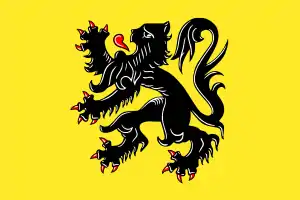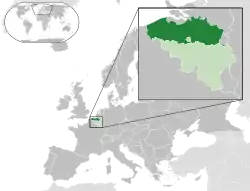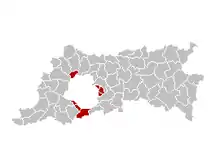Flemish Region
The Flemish Region (Dutch: Vlaams Gewest, pronounced [ˌvlaːms xəˈʋɛst] (![]() listen);[3] French: Région flamande; German: Flämische Region), usually simply referred to as Flanders (Dutch: Vlaanderen [ˈvlaːndərə(n)] (
listen);[3] French: Région flamande; German: Flämische Region), usually simply referred to as Flanders (Dutch: Vlaanderen [ˈvlaːndərə(n)] (![]() listen); French: Flandre [flɑ̃dʁ]; German: Flandern [ˈflandɐn] (
listen); French: Flandre [flɑ̃dʁ]; German: Flandern [ˈflandɐn] (![]() listen)), is one of the three regions of Belgium—alongside the Walloon Region and the Brussels-Capital Region. It occupies the northern part of Belgium and covers an area of 13,625 km2 (5,261 sq mi) (44.4% of Belgium). It is one of the most densely populated regions of Europe with around 490/km2 (1,300/sq mi).
listen)), is one of the three regions of Belgium—alongside the Walloon Region and the Brussels-Capital Region. It occupies the northern part of Belgium and covers an area of 13,625 km2 (5,261 sq mi) (44.4% of Belgium). It is one of the most densely populated regions of Europe with around 490/km2 (1,300/sq mi).
Flemish Region
| |
|---|---|
 Flag | |
| Anthem: De Vlaamse Leeuw ("The Flemish Lion") | |
 | |
| Country | |
| Community | |
| Seat | City of Brussels (which is not part of the Flemish Region) |
| Government | |
| • Executive | Flemish Government |
| • Governing parties (2019) | N-VA, CD&V, Open Vld |
| • Minister-President | Jan Jambon (N-VA) |
| • Legislature | Flemish Parliament |
| • Speaker | Jan Peumans (N-VA) |
| Area | |
| • Total | 13,626 km2 (5,261 sq mi) |
| Population (1 January 2020)[2] | |
| • Total | 6,629,143 |
| • Density | 490/km2 (1,300/sq mi) |
| Demographics | |
| • Ethnic group | Flemings |
| • Languages | Dutch French (in municipalities with language facilities) |
| ISO 3166 code | BE-VLG |
| Celebration Day | 11 July |
| Website | Flanders.be |
The Flemish Region should not be confused with the Flemish community: the latter encompasses both the inhabitants of the Flemish Region and the Dutch-speaking minority living in the Brussels-Capital Region.
Politics
Immediately after its establishment in 1980, the region transferred all its constitutional competencies to the Flemish Community. Thus, the current Flemish authorities (Flemish Parliament and Flemish Government) represent all the Flemish people, including those living in the Brussels-Capital Region. Hence, the Flemish Region is governed by the Flemish Community institutions. However, members of the Flemish Community parliament elected in the Brussels-Capital Region have no right to vote on Flemish regional affairs.
Administrative divisions

The Flemish Region comprises five provinces, each consisting of administrative arrondissements that, in turn, contain municipalities (in total 300 municipalities in Flanders).
The seat of the Flemish parliament is located in Brussels, which is an enclave within – but not part of – the Flemish region, being specified that the Brussels-Capital Region is established as an administrative region of Belgium in its own right. In contrast, the Walloon parliament has established its parliament in the territory of Wallonia, specifically in the city of Namur, Namur Province.
Both the Flemish Community (which is a different entity from the Flemish Region) and French Community (which is a different entity from Wallonia) have jurisdiction over the area of the Brussels-Capital Region. Consequently, these constituent constitutional linguistic communities, unlike their somewhat related regions, do not have a defined number of inhabitants. Both of these communities have their institutions in Brussels.
| Province | Capital city | Administrative arrondissements | Population (1 January 2020)[2] | Area[1] | Population density | |
|---|---|---|---|---|---|---|
| 1 | Antwerp (Antwerpen) | Antwerpen, Mechelen, Turnhout | 1,869,730 | 2,876 km2 (1,110 sq mi) | 650/km2 (1,700/sq mi) | |
| 2 | Hasselt | Hasselt, Maaseik, Tongeren | 877,370 | 2,427 km2 (937 sq mi) | 360/km2 (930/sq mi) | |
| 3 | Ghent (Gent) | Aalst, Dendermonde, Eeklo, Gent, Oudenaarde, Sint-Niklaas | 1,525,255 | 3,007 km2 (1,161 sq mi) | 510/km2 (1,300/sq mi) | |
| 4 | Leuven | Halle-Vilvoorde, Leuven | 1,155,843 | 2,118 km2 (818 sq mi) | 550/km2 (1,400/sq mi) | |
| 5 | Bruges (Brugge) | Brugge, Diksmuide, Ieper, Kortrijk, Oostende, Roeselare, Tielt, Veurne | 1,200,945 | 3,197 km2 (1,234 sq mi) | 380/km2 (980/sq mi) | |
| Flemish Region | 22 | 6,629,143 | 13,626 km2 (5,261 sq mi) | 490/km2 (1,300/sq mi) | ||
Economy
Flanders is home to a diversified modern economy, with emphasis put on research and development. Many enterprises work closely with local knowledge and research centres to develop new products and services.[4] The Gross domestic product (GDP) of the region was 269.9 billion € in 2018, accounting for 59% of Belgiums economic output. GDP per capita adjusted for purchasing power was 36,300 € or 136% of the EU27 average in the same year.[5]
Transport

"De Lijn" serves as the main public transport company, run by the Flemish government. It consists of buses and trams. TEC is the equivalent company in Wallonia, and MIVB-STIB in Brussels. The railway network run by the NMBS, however, is a federal responsibility.
The Flemish government is also responsible for about 500 kilometers of regional roads (Dutch: gewestwegen) and about 900 kilometers of highways in the territory of the Flemish Region. Other types of roads are provincial roads and municipal roads.
Demographics
Cities
Largest cities in the region include (with population figures as of 1 January 2018):[6]
- Antwerp (523,248)
- Ghent (260,341)
- Bruges (118,284)
- Leuven (101,396)
- Mechelen (86,304)
- Aalst (85,715)
- Hasselt (77,651)
- Sint-Niklaas (76,756)
- Kortrijk (76,265)
- Ostend (71,332)
- Genk (66,110)
- Roeselare (62,301)
The Flemish Diamond (Dutch: Vlaamse Ruit) is the name of the central, populous area in Flanders and consists of several of these cities, such as Antwerp, Ghent, Leuven and Mechelen. Approximately 5,500,000 people live in the area.
Language
The official language is Dutch, sometimes colloquially referred to as Flemish. The main dialect groups include West Flemish, East Flemish, Brabantian and Limburgish.

French may be used for certain administrative purposes in a limited number of the so-called "municipalities with language facilities" around the Brussels-Capital Region and on the border with Wallonia.
"Rim municipalities" (around Brussels) are Drogenbos, Kraainem, Linkebeek, Sint-Genesius-Rode, Wemmel and Wezembeek-Oppem. Brussels was originally a Dutch-speaking city, but it was francised in the 19th and 20th century and is now largely French-speaking.
Municipalities with language facilities on the border with Wallonia are Bever (French: Biévène), Herstappe, Mesen (French: Messines), Ronse (French: Renaix), Spiere-Helkijn (French: Espierres-Helchin), Voeren (French: Fourons).
Religion
Religion in the Flemish Region in 2016[7]
According to a 2016 survey by the Free University of Brussels, 63% of Flemish citizens are Roman Catholic, 2% are Protestant, 26% have not religion, while 2% have other religions.[7]
See also
References
- "Occupation du sol sur base du Registre cadastral, Belgique. Revenus en euro. Superficies en hectare. Superficie totale en pour mille" [Land use based on the cadastral register, Belgium. Income in euros. Areas in hectare. Total area in per thousand]. Statistics Belgium (in French). 11 April 2020. Retrieved 9 February 2021.
- "On 1 January 2020, Belgium had 11,492,641 inhabitants". Statistics Belgium. 26 May 2020. Retrieved 9 February 2021.
- In isolation, gewest is pronounced [ɣəˈʋɛst].
- "Flanders | Flanders fits you". Flanders.be. Archived from the original on 21 January 2012. Retrieved 3 July 2011.
- "Regional GDP per capita ranged from 30% to 263% of the EU average in 2018". Eurostat.
- "kek_demo". Aps.vlaanderen.be. Archived from the original on 18 December 2009. Retrieved 3 July 2011.
- "Un sondage ORELA/IPSOS/Le Soir/RTBF : « Les Belges francophones et la religion »" (in French). Université libre de Bruxelles. Retrieved 17 December 2020.
- "ベルギー3地域と「友好交流及び相互協力に関する覚書」を締結". Retrieved 15 May 2017.
External links
| Wikimedia Commons has media related to Flanders. |
- (in English) Flemish authorities (Dutch: Vlaamse overheid).
- (in English) Flanders online (also in French, German and Dutch).
- Toerisme Vlaanderen
- (in French) French Flanders
- (in Dutch) Frans-Vlaanderen
- (in Dutch) The Flemish region reaches 6 million inhabitants

